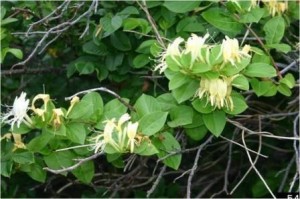Japanese honeysuckle is a trailing woody vine with white tubular flowers that yellow later in the season prior to formation of purplish-black berries. It is commonly found along roadsides, forest edges, and in abandoned fields as it quickly invades natural areas after disturbances such as logging, floods, or windstorms. Japanese honeysuckle spreads by seeds, rhizomes, and runners. It can quickly cover small trees, either stunting their growth or killing them completely. Dense growth of the species will also reduce light available to other species, deplete soil moisture nutrients, and may cause trees to topple due to the weight of its vines.
A.Hand-pulling:
Small patches of Japanese honeysuckle can be eliminated by hand pulling and removal of trailing vines. All roots and shoots need to be removed from the site and disposed of properly.
B.Mowing:
Mowing is not an effective control method for Japanese honeysuckle since removal of aboveground growth will stimulate additional growth and encourage formation of dense mats. However, mowing twice a year can reduce vegetative spread although stem density may increase. Cut material must also be removed from the site to prevent rooting and additional spread.
C. Herbicides:
During active growth, spray Japanese honeysuckle vines with triclopyr. Because its leaves stay green well into winter, Japanese honeysuckle can be controlled with mid to late fall sprays of triclopyr or glyphosate. An autumn application also reduces potential injury to non-target plants that have senesced by that time.
Foliar sprays:
ROUNDUP [glyphosate (41%)]: 2 fl. oz./gal
BRUSH-B-GON [triclopyr (8%)]: 4 fl. oz./gal
References
Nuzzo, V. 1997. Element Stewardship Abstract for Lonicera japonica Japanese Honeysuckle. Ed. J.M. Randall. The Nature Conservancy.
Williams, C.E. 199?. Invasive Alien Plant Species of Virginia: Japanese Honeysuckle (Lonicera japonica Thunberg.).
